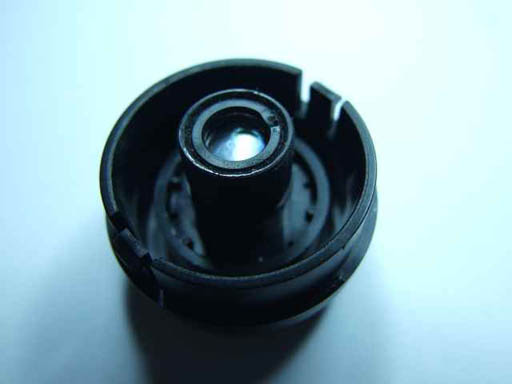Webcam filter removal
Labtec Webcam Pro
By Deimos

Hello fellow FreeTrack users.
I've recently been able to convert my Labtec Webcam Pro to an IR cam, and it works just great with FreeTrack.
WARNING: This conversion is IRREVERSIBLE, and can damage your camera if not done carefully enough, so think twice before you start, and work slowly and carefully if you do.
So getting to the point, here's some info on how to do it:
First, you'll need to unscrew the lens from the camera. Before the end they will start turning harder - there are latches preventing the lens from falling out, but since that's just what we're trying to accomplish, just ignore it and keep turning until you have the lens in you hand. Put the camera aside, since there's nothing we need to do with it. Covering the opening where the lens were with something might be a good idea, since any dust gathered on the sensor will reduce image quality.
You'll notice that there's a plastic ring holding lens together inside the tube, as seen on this picture:

You should have no trouble carefully prying it out with a sharp knife, like this: (of course you should hold the lens with the other hand, but i had do take the photo somehow )

After removing the plastic ring, you'll be able to get one of the lens out, just watch out not to scratch it:

Bellow it is another plastic ring, this one much thinner. Be careful not to lose it.
Here's how it looks disassembled:

See the orange reflective coat on the flat side of the lens you took out? That's the IR filter. The problem is that it is a coating in the lens, not a separate part. It has to be removed mechanically, and obviously, cannot be put back. Fortunately, the lens are made of glass, so they can survive the procedure without harm. I used a Dremel rotary tool with felt polishing attachment and some polishing compound. This way the lens didn't have any scratches on them after removing the IR filter. But as i said, they're made of glass so if you don't have access to polishing tools, you could try using very fine sandpaper or a sharp knife and polish the lens afterwards (warning - do this at your own responsibility).
After the hardest part (removing the filter) is done, you can insert the visible light filter into the camera to make it see only IR light, or just leave it as it is to make it work in both daylight and IR light. FreeTrack works best if the ambient daylight is filtered out, but you can always attach the filter outside the lens so it can be removed at will. Floppy disk tape is best for FT but I want to be able to take IR pictures so I used a weaker IR filter; photographic film. I decided to mount the filter inside the camera, so i cut out three small wheels (about 8mm diameter - the size of the thinner plastic spacer from inside of the lens) from the black part of developed photographic film.

Just one last step before you finish - clean the lens thoroughly, best using some pure alcohol like isopropanol, or ethanol, or at least using some detergent. Any fingerprints remaining on them will reduce picture quality. Also chech if there isn't any dirt or dust inside the tube on the next lens before putting the ones you removed back.
Now it's time to put it all back together - the thin plastic spacer ring goes in first, optionally is followed by two or three layers of the visible light filter, then the lens - flat side goes down towards the filter, and finally close the lens by pushing back the thick plastic ring that held it all together.
Just screw the lens back, adjust focus, and congratulations - you have an IR cam
Here are some pictures taken with my modified webcam:
A Polish 10zl bill - only part of the print is visible.

My FreeTrack cap at minimal exposure and minimal gain setting - I think I'll have to reduce the current to the LEDs - they're a bit too bright now.

Here's a more sane setting - about 20mA for the LEDs, and they are shining straight at the cam, just like in the previous case:

And here's the same cap with the same power source, but with a magnetic disk filter:

Of course it's up to whoever modifies the cam if he/she wants to be able to use the camera only with FT (then magnetic disk filter is the best), or also as a IR/nightvision camera (then the photo film still works the best).
I've been thinking of making easily interchangeable filters for various appliances - then without any filter it can work as an ordinary color webcam, but with much better picture quality in low light/artificial light conditions than unmodified one, with a photo film filter it can be used to watch the world in IR, and with a filter made of floppy disk it rocks in FreeTrack.
